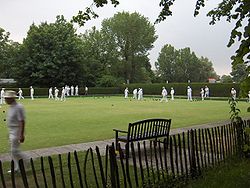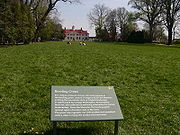
Bowling green
Encyclopedia



Lawn
A lawn is an area of aesthetic and recreational land planted with grasses or other durable plants, which usually are maintained at a low and consistent height. Low ornamental meadows in natural landscaping styles are a contemporary option of a lawn...
for playing the game of lawn bowls
Bowls
Bowls is a sport in which the objective is to roll slightly asymmetric balls so that they stop close to a smaller "jack" or "kitty". It is played on a pitch which may be flat or convex or uneven...
.
Before 1830, when Edwin Beard Budding
Edwin Beard Budding
Edwin Beard Budding , an engineer from Stroud, England, was the English inventor of the lawnmower and adjustable spanner.-Lawnmower:...
invented the lawnmower, lawns were often kept cropped by grazing sheep on them. The world's oldest surviving bowling green is the Southampton Old Bowling Green
Southampton Old Bowling Green
Southampton Old Bowling Green, situated on the corner of Lower Canal Walk and Platform Road, Southampton, England is the world's oldest surviving bowling green having been first used in 1299.-History:...
, which was first used in 1299.
When the French adopted "boulingrin" in the 17th century, it was understood to mean a sunk geometrically shaped piece of perfect grass, framed in gravel walks, which often formed the center of a regularly planted wood called a bosquet
Bosquet
In the French formal garden, a bosquet is a formal plantation of trees, at least five of identical species planted as a quincunx, or set in strict regularity as to rank and file, so that the trunks line up as one passes along either face...
, somewhat like a highly formalized glade; it might have a central pool or fountain.
The diarist Samuel Pepys
Samuel Pepys
Samuel Pepys FRS, MP, JP, was an English naval administrator and Member of Parliament who is now most famous for the diary he kept for a decade while still a relatively young man...
relates a conversation he had with the architect Hugh May:
- "Then walked to Whitehall, where saw nobody almost, but walked up and down with Hugh MayHugh MayHugh May was an English architect in the period after the Restoration of King Charles II. He worked in the era which fell between the first introduction of Palladianism into England by Inigo Jones, and the full flowering of English Baroque under John Vanbrugh and Nicholas Hawksmoor. His own work...
, who is a very ingenious man. Among other things, discoursing of the present fashion of gardens to make them plain, that we have the best walks of gravell in the world, France having none, nor Italy; and our green of our bowling allies is better than any they have."
Dimensions and other specifications
Bowling green specifications are stipulated in the Laws of the Sport of Bowls.Several games of bowls can be played on a bowling green at the same time. The number of games depends on the dimensions of the green. Each game is played on its own portion of the green. These divided portions of the green are called rinks.
The length of a green in the direction of play will be between 31 metres and 40 metres. The green should have a suitable level playing surface made of grass or of an approved synthetic material.
The green is surrounded by a ditch between 200 millimetres and 380 millimetres wide, and between 50 millimetres and 200 millimetres deep. The ditch has a bank against its outer edge. The top of the bank should be at least 230 millimetres about the surface level of the green.
Generally, greens are built in a square shape as close to 40 metres as possible. This allows for games to be played in either direction. The advantages of playing in different directions are that: the wear on the green is more even, and; the players do not need to face towards the sun when playing.
In cities, where outdoor space is limited, greens are rarely 40 metres in length (however, they are generally still square).
It is not unusual to find greens that are rectangular in shape. On rectangular greens games are played in one direction only. The length of a rectangular green is still between 31 metres and 40 metres. The width can vary from as little as 8 metres (enough for one rink) to as much as 60 metres or more.
The width of a rink for outdoor play will be between 4.3 metres and 5.8 metres (for indoor play the minimum width of a rink is 4.6 metres). The centre line of the rink can be marked along the surface of the green starting at 2 metres from each end ditch. The side boundaries of each rink are shown by boundary pegs. The side boundary of the outside rink (also called a ditch rink) should be at least 600 millimetres from the side ditch (460 millimetres for indoor greens).

